Practical Excel Tips Sharing: How to Ignore Error Values for Sum
"How to sum data that contains error values? If we sum it directly, the result obtained is also an error value. What should we do?" Don't worry, today this article will share with you three methods Let’s take a look at the method of summing directly ignoring the error values using formulas!

#Quote the existing receipt amount according to the corresponding order number. I believe many friends can handle this problem and can use the VLOOKUP function to solve it.
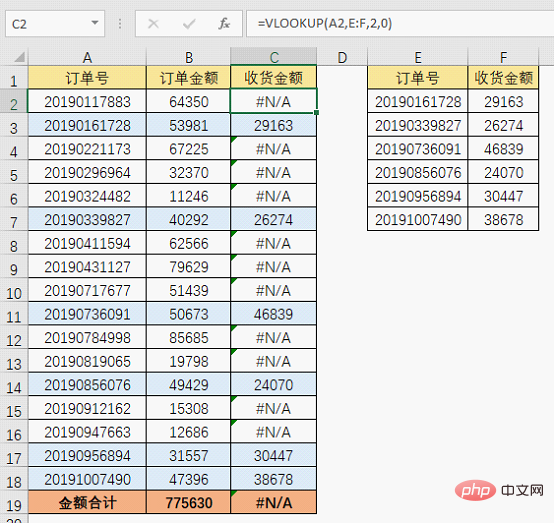
What we are going to discuss today is how to sum data that contains incorrect values.
If you sum directly, the result is also an error value, as shown below:
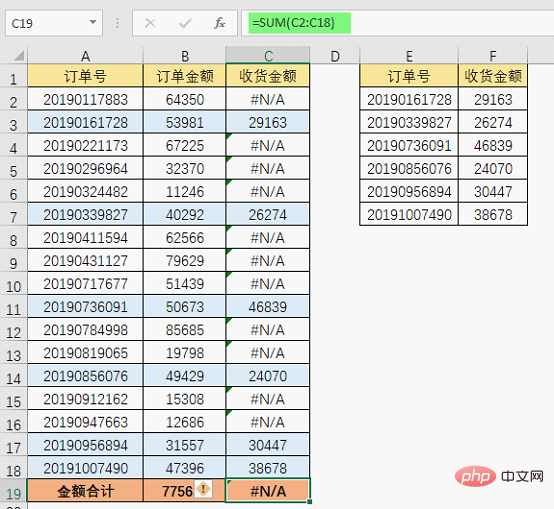
For this kind of data that needs to be summed with error values situation, today the veteran will share how to deal with three formulas. I hope that everyone can grasp the ideas for solving problems through the analysis of the formulas, draw inferences from one example, and gain a comprehensive understanding.
Formula routine 1: SUM IFERROR combination
The SUM function is indispensable for summation, and the IFERROR function is naturally indispensable for dealing with error values. Therefore, by combining these two functions, you can achieve the purpose of summing ignoring error values. The formula is: =SUM(IFERROR(C2:C18,0))
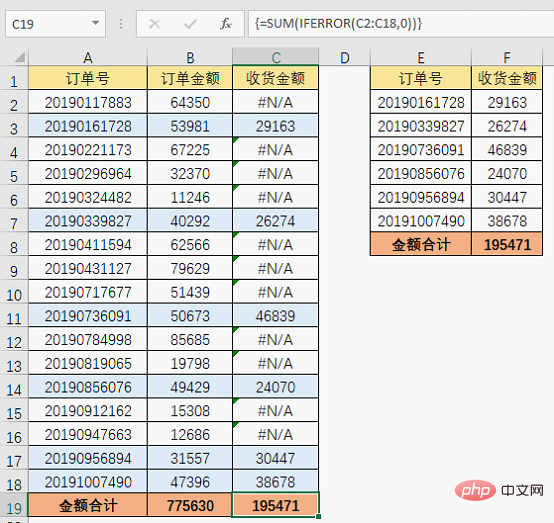
Formula analysis:
The IFERROR function has only two parameters, and the format is IFERROR (data to be processed, the result returned when the data is an error). In this example, the data to be processed is the area C2:C18 where the receipt amount is located. When the receipt amount is an error value, 0 is returned. Therefore, the result of IFERROR(C2:C18,0) is:
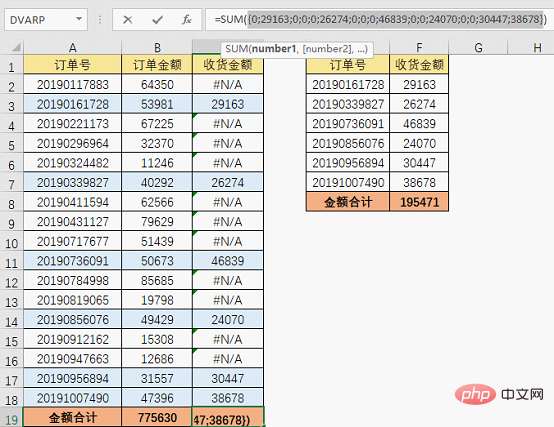
Because the first parameter of IFERROR refers to the cell range, this will get a set of numbers, so When using the SUM function to perform sums, you need to hold down the Ctrl Shift and Enter keys at the same time to generate an array formula. At this time, curly brackets will automatically appear on both sides of the formula, and the formula will obtain the correct result.
Formula routine 2: SUMIF function
The SUMIF function is also a very commonly used function. Its basic function is to perform summation according to specified conditions. The format is SUMIF (condition area, condition, summation area). When the condition area and the summation area are consistent, the summation area can be omitted.
What is actually done in this example is to sum the data greater than 0. The error value is not even a number, so of course it does not meet the condition of being greater than 0. Therefore, the formula is =SUMIF(C2:C18,">0")
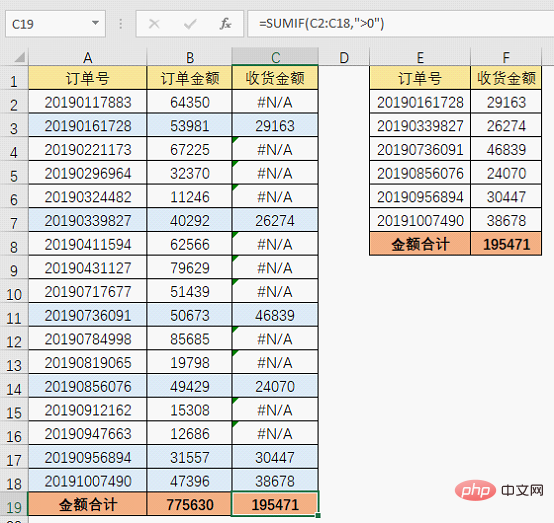
If the data you need to process are not all numbers greater than 0, you need to use the following Formula: =SUMIF(C2:C18,"<9e307")
9e307 means 9*10^307, which is almost the maximum value that Excel can accept. So data smaller than the maximum number are summed, and error values can be ignored.
Formula routine 3: AGGREGATE function
Let’s talk about the AGGREGATE function, which is a very powerful multi-functional statistical function. It is better than the one mentioned before. The SUBTOTAL function is even more powerful! In this example we are only using one of its many features and ignoring the summation of error values.
This function has four parameters. The basic structure is AGGREGATE (function code, which data to ignore, data area to be counted, k value). The fourth parameter is only needed for certain special functions. , ignored in this example, the formula is: =AGGREGATE(9,6,C2:C18).
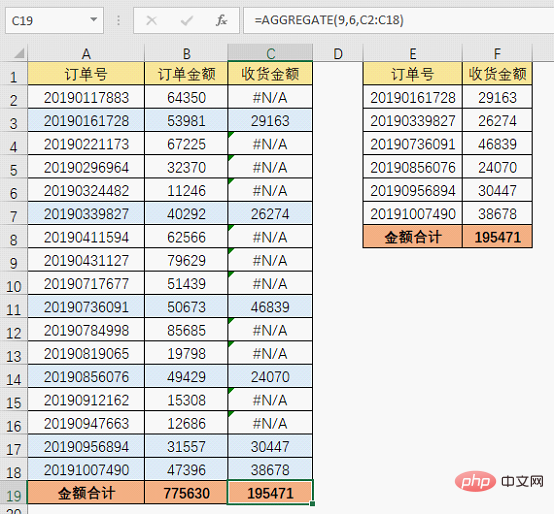
There are 19 options for the first parameter, 9 means summation.
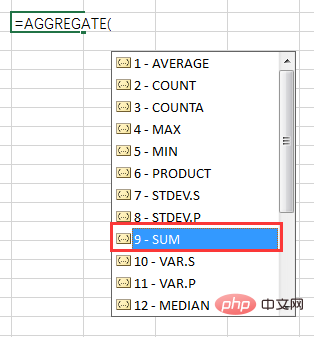
There are 8 options for the second parameter, 6 means ignoring the error value.
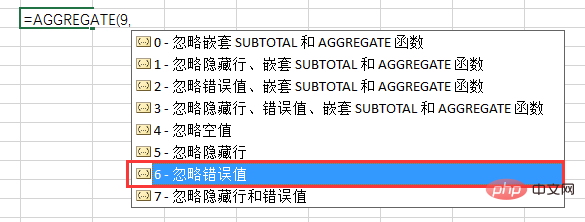
Related learning recommendations: excel tutorial
The above is the detailed content of Practical Excel Tips Sharing: How to Ignore Error Values for Sum. For more information, please follow other related articles on the PHP Chinese website!

Hot AI Tools

Undresser.AI Undress
AI-powered app for creating realistic nude photos

AI Clothes Remover
Online AI tool for removing clothes from photos.

Undress AI Tool
Undress images for free

Clothoff.io
AI clothes remover

Video Face Swap
Swap faces in any video effortlessly with our completely free AI face swap tool!

Hot Article

Hot Tools

Notepad++7.3.1
Easy-to-use and free code editor

SublimeText3 Chinese version
Chinese version, very easy to use

Zend Studio 13.0.1
Powerful PHP integrated development environment

Dreamweaver CS6
Visual web development tools

SublimeText3 Mac version
God-level code editing software (SublimeText3)

Hot Topics
 1386
1386
 52
52
 What should I do if the frame line disappears when printing in Excel?
Mar 21, 2024 am 09:50 AM
What should I do if the frame line disappears when printing in Excel?
Mar 21, 2024 am 09:50 AM
If when opening a file that needs to be printed, we will find that the table frame line has disappeared for some reason in the print preview. When encountering such a situation, we must deal with it in time. If this also appears in your print file If you have questions like this, then join the editor to learn the following course: What should I do if the frame line disappears when printing a table in Excel? 1. Open a file that needs to be printed, as shown in the figure below. 2. Select all required content areas, as shown in the figure below. 3. Right-click the mouse and select the "Format Cells" option, as shown in the figure below. 4. Click the “Border” option at the top of the window, as shown in the figure below. 5. Select the thin solid line pattern in the line style on the left, as shown in the figure below. 6. Select "Outer Border"
 How to filter more than 3 keywords at the same time in excel
Mar 21, 2024 pm 03:16 PM
How to filter more than 3 keywords at the same time in excel
Mar 21, 2024 pm 03:16 PM
Excel is often used to process data in daily office work, and it is often necessary to use the "filter" function. When we choose to perform "filtering" in Excel, we can only filter up to two conditions for the same column. So, do you know how to filter more than 3 keywords at the same time in Excel? Next, let me demonstrate it to you. The first method is to gradually add the conditions to the filter. If you want to filter out three qualifying details at the same time, you first need to filter out one of them step by step. At the beginning, you can first filter out employees with the surname "Wang" based on the conditions. Then click [OK], and then check [Add current selection to filter] in the filter results. The steps are as follows. Similarly, perform filtering separately again
 How to change excel table compatibility mode to normal mode
Mar 20, 2024 pm 08:01 PM
How to change excel table compatibility mode to normal mode
Mar 20, 2024 pm 08:01 PM
In our daily work and study, we copy Excel files from others, open them to add content or re-edit them, and then save them. Sometimes a compatibility check dialog box will appear, which is very troublesome. I don’t know Excel software. , can it be changed to normal mode? So below, the editor will bring you detailed steps to solve this problem, let us learn together. Finally, be sure to remember to save it. 1. Open a worksheet and display an additional compatibility mode in the name of the worksheet, as shown in the figure. 2. In this worksheet, after modifying the content and saving it, the dialog box of the compatibility checker always pops up. It is very troublesome to see this page, as shown in the figure. 3. Click the Office button, click Save As, and then
 How to type subscript in excel
Mar 20, 2024 am 11:31 AM
How to type subscript in excel
Mar 20, 2024 am 11:31 AM
eWe often use Excel to make some data tables and the like. Sometimes when entering parameter values, we need to superscript or subscript a certain number. For example, mathematical formulas are often used. So how do you type the subscript in Excel? ?Let’s take a look at the detailed steps: 1. Superscript method: 1. First, enter a3 (3 is superscript) in Excel. 2. Select the number "3", right-click and select "Format Cells". 3. Click "Superscript" and then "OK". 4. Look, the effect is like this. 2. Subscript method: 1. Similar to the superscript setting method, enter "ln310" (3 is the subscript) in the cell, select the number "3", right-click and select "Format Cells". 2. Check "Subscript" and click "OK"
 How to set superscript in excel
Mar 20, 2024 pm 04:30 PM
How to set superscript in excel
Mar 20, 2024 pm 04:30 PM
When processing data, sometimes we encounter data that contains various symbols such as multiples, temperatures, etc. Do you know how to set superscripts in Excel? When we use Excel to process data, if we do not set superscripts, it will make it more troublesome to enter a lot of our data. Today, the editor will bring you the specific setting method of excel superscript. 1. First, let us open the Microsoft Office Excel document on the desktop and select the text that needs to be modified into superscript, as shown in the figure. 2. Then, right-click and select the "Format Cells" option in the menu that appears after clicking, as shown in the figure. 3. Next, in the “Format Cells” dialog box that pops up automatically
 How to use the iif function in excel
Mar 20, 2024 pm 06:10 PM
How to use the iif function in excel
Mar 20, 2024 pm 06:10 PM
Most users use Excel to process table data. In fact, Excel also has a VBA program. Apart from experts, not many users have used this function. The iif function is often used when writing in VBA. It is actually the same as if The functions of the functions are similar. Let me introduce to you the usage of the iif function. There are iif functions in SQL statements and VBA code in Excel. The iif function is similar to the IF function in the excel worksheet. It performs true and false value judgment and returns different results based on the logically calculated true and false values. IF function usage is (condition, yes, no). IF statement and IIF function in VBA. The former IF statement is a control statement that can execute different statements according to conditions. The latter
 Where to set excel reading mode
Mar 21, 2024 am 08:40 AM
Where to set excel reading mode
Mar 21, 2024 am 08:40 AM
In the study of software, we are accustomed to using excel, not only because it is convenient, but also because it can meet a variety of formats needed in actual work, and excel is very flexible to use, and there is a mode that is convenient for reading. Today I brought For everyone: where to set the excel reading mode. 1. Turn on the computer, then open the Excel application and find the target data. 2. There are two ways to set the reading mode in Excel. The first one: In Excel, there are a large number of convenient processing methods distributed in the Excel layout. In the lower right corner of Excel, there is a shortcut to set the reading mode. Find the pattern of the cross mark and click it to enter the reading mode. There is a small three-dimensional mark on the right side of the cross mark.
 How to insert excel icons into PPT slides
Mar 26, 2024 pm 05:40 PM
How to insert excel icons into PPT slides
Mar 26, 2024 pm 05:40 PM
1. Open the PPT and turn the page to the page where you need to insert the excel icon. Click the Insert tab. 2. Click [Object]. 3. The following dialog box will pop up. 4. Click [Create from file] and click [Browse]. 5. Select the excel table to be inserted. 6. Click OK and the following page will pop up. 7. Check [Show as icon]. 8. Click OK.




